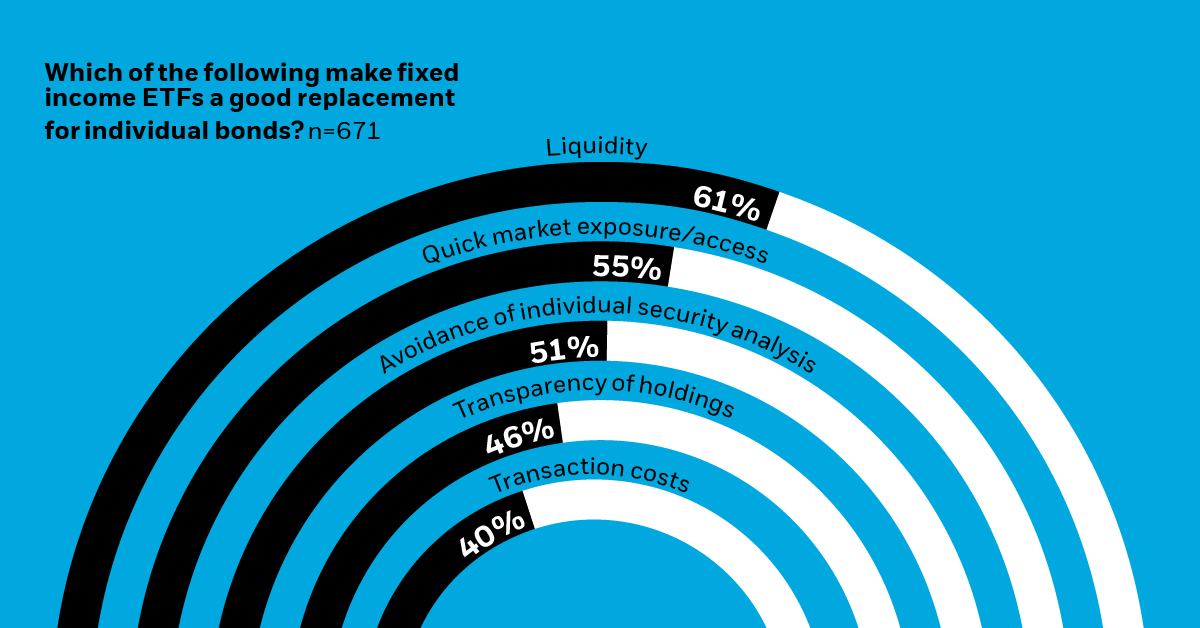Fixed Income ETFs: Investors’ Ticket to Flexibility
The following content is sponsored by iShares

Download the ETF Snapshot for free.
Fixed Income ETFs: Investors’ Ticket to Flexibility
When market volatility surges, fixed income investors encounter multiple pressure points. For example, they may face difficulties with liquidity, price discovery, and transaction costs.
In this infographic from iShares, we show how fixed income ETFs help address these challenges. It’s the second in a five-part series covering key insights from the ETF Snapshot, a comprehensive report on how institutional investors manage volatility.
The Methodology
To assess the role that ETFs play, Institutional Investor published a report in 2021 based on a survey of 766 decision makers. Respondents were from various types of organizations, firm sizes, and regions.
For instance, here is how responses broke down by location:
- 21% Asia Pacific
- 36% North America
- 29% Europe, Middle East and Africa
- 14% Latin America
Here’s what the survey found.
Encountering Roadblocks
During 2020 market volatility, the vast majority of institutional investors said they had difficulty sourcing (95%) and/or transacting (92%) in individual bonds.
Smaller firms faced these roadblock more often than larger institutions.
| Assets Under Management | % Who Faced Great Difficulty Sourcing Bonds |
|---|---|
| $5B or less | 61% |
| $5B-$50B | 46% |
| $50B+ | 42% |
How did institutional investors overcome these liquidity challenges?
Turning to Fixed income ETFs
More than half of institutions increased their use of ETFs as they looked to source, price, and transact bonds. In fact, in the first three months of 2020, fixed income ETF trading volume reached $1.3 trillion—half of 2019’s total.
ETFs also became more popular relative to their underlying basket of securities. During extreme volatility in April 2020, ETF trading volume relative to the underlying securities was three times higher than the 2019-2020 average.
With their higher liquidity, ETFs also helped institutional investors with price discovery.
“When there was no trading activity in certain corporate bonds, you can use the ETFs as a pretty good proxy for what people are willing to pay and what the appetite is.”
—Senior Analyst, Asset Management firm
However, the usefulness of fixed income ETFs goes far beyond liquidity.
Want more institutional insights into ETFs?
Download The ETF Snapshot for free.
A Versatile Tool
Institutional investors said fixed income ETFs were a good replacement for individual bonds for a number of reasons.
| Reason | % of Respondents |
|---|---|
| Liquidity | 61% |
| Quick Market Exposure/Access | 55% |
| Avoidance of Individual Security Analysis | 51% |
| Transparency of Holdings | 46% |
| Transaction Costs | 40% |
The difference in transaction costs is particularly evident in the fixed income landscape. During extreme market volatility in March 2020, the bid-ask spread* for the iShares High Yield Corporate Bond ETF was 48 times smaller than the underlying securities.
* A bid-ask spread measures the difference between what an investor is willing to buy a fund for (the bid price) and the price an investor is willing to sell for (the ask price). A smaller bid-ask spread indicates greater cost efficiency.
In light of these attributes, fixed income ETFs are a go-to tool for institutional investors. In fact, they were top-rated for a number of use cases.
| Purpose | % of Respondents |
|---|---|
| Portfolio Rebalancing | 62% |
| Tactical Adjustments | 66% |
| Derivative Complement/Replacement | 66% |
| Transition Management | 74% |
| Liquidity Management | 83% |
One senior analyst at an asset management firm noted that it was easy to get granular with asset allocation because there are so many ETFs with plenty of liquidity.
The Future of Fixed Income ETFs
As of May 2021, fixed income ETFs made up 18% of all ETF assets under management. It’s likely that their role could become more prominent in the future.
For instance, 34% of institutional investors are likely to increase their use of fixed income ETFs going forward. One thing is evident: fixed income ETFs have proven to be flexible tools, especially during heightened market volatility.
Download the ETF snapshot for free.
-

 Sponsored3 years ago
Sponsored3 years agoMore Than Precious: Silver’s Role in the New Energy Era (Part 3 of 3)
Long known as a precious metal, silver in solar and EV technologies will redefine its role and importance to a greener economy.
-

 Sponsored7 years ago
Sponsored7 years agoThe History and Evolution of the Video Games Market
Everything from Pong to the rise of mobile gaming and AR/VR. Learn about the $100 billion video games market in this giant infographic.
-

 Sponsored8 years ago
Sponsored8 years agoThe Extraordinary Raw Materials in an iPhone 6s
Over 700 million iPhones have now been sold, but the iPhone would not exist if it were not for the raw materials that make the technology...
-

 Sponsored8 years ago
Sponsored8 years agoThe Industrial Internet, and How It’s Revolutionizing Mining
The convergence of the global industrial sector with big data and the internet of things, or the Industrial Internet, will revolutionize how mining works.









